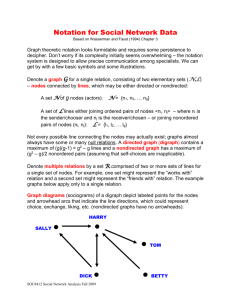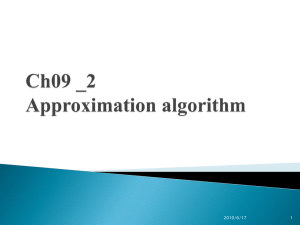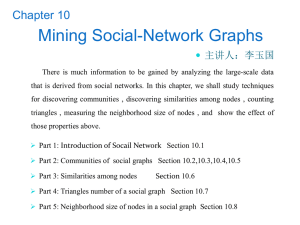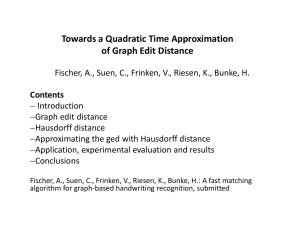Supplementary Appendix.
advertisement
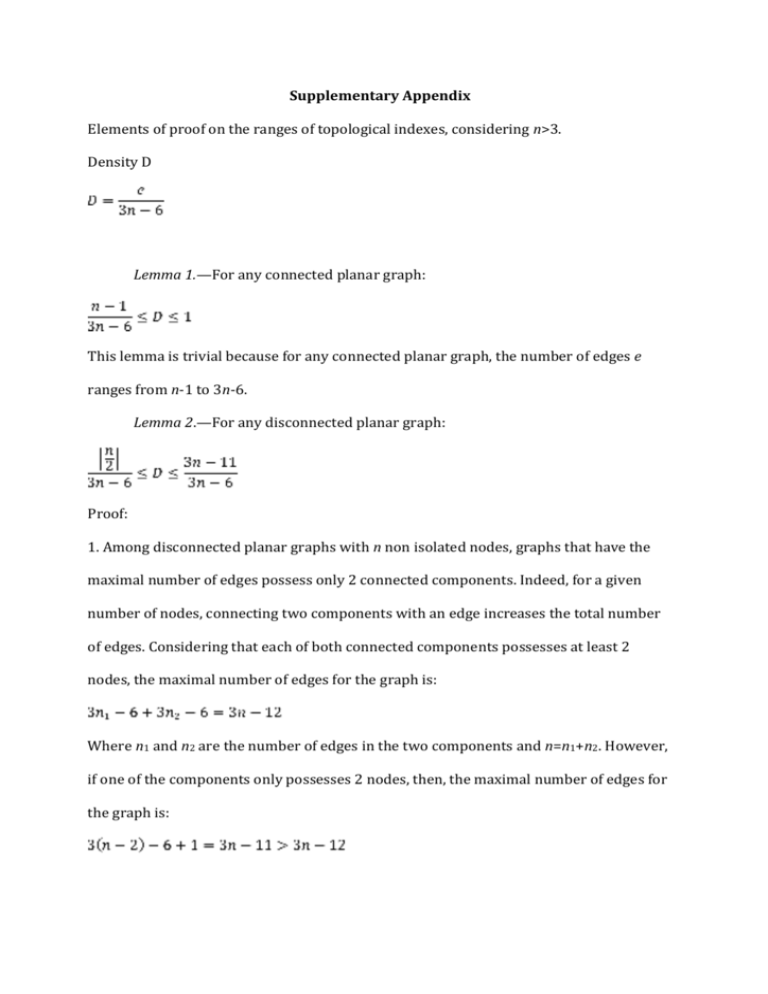
Supplementary Appendix Elements of proof on the ranges of topological indexes, considering n>3. Density D Lemma 1.—For any connected planar graph: This lemma is trivial because for any connected planar graph, the number of edges e ranges from n-1 to 3n-6. Lemma 2.—For any disconnected planar graph: Proof: 1. Among disconnected planar graphs with n non isolated nodes, graphs that have the maximal number of edges possess only 2 connected components. Indeed, for a given number of nodes, connecting two components with an edge increases the total number of edges. Considering that each of both connected components possesses at least 2 nodes, the maximal number of edges for the graph is: Where n1 and n2 are the number of edges in the two components and n=n1+n2. However, if one of the components only possesses 2 nodes, then, the maximal number of edges for the graph is: Consequently, for disconnected graphs, D reaches is maximal value for 2 components, with one possessing 2 nodes. 2. Among disconnected planar graphs with n nodes, conversely, graphs candidate to have the minimal number of edges must possess the highest number of components (with at least 2 nodes). This number of connected components is (n-1)/2 if n is odd). The corresponding number of edges is (n/2 if n is even, or (n/2 if n is even, or (n+1)/2 if n is odd). Eccentricity E Recall that for a connected graph with n nodes, the maximal eccentricity is for disconnected graphs with and that components, the eccentricity is defined by . Lemma 3.—For any disconnected planar graph with n non-isolated nodes: Proof: Among disconnected planar graphs with n nodes, graphs candidate to have the maximal eccentricity are composed by 2 components. Indeed, connecting 2 components increases the radius of the graph. Considering now a graph with 2 connected components (one with n1 nodes and the other with n-n1 nodes), each one with maximal eccentricity, we have: Depending on the parity of n and n1, we have four situations. Simple calculations show that the maximal radius is obtained for n1 =2 or n1 =n-2. Complexity C Let consider here only graphs with more than 5 nodes, the other cases being elementary. Lemma 4.—The maximal complexity is nodes and for connected planar graphs with n for disconnected planar graphs with n non isolated nodes. Proof: there exists a connected planar graph consisting of two nodes of degree n-1and n2 nodes of degree 4 that reaches the maximum number of edges among planar graphs with n nodes (e=3n-6)and the minimal eccentricity (E=1). So the lemma is proved for connected graphs. In the same way, there exists a disconnected graph with two connected components that reaches the maximum number of edges among disconnected planar graphs with n isolated nodes (e=3n-11)and the minimal eccentricity (E=1). Lemma 5.—The minimal complexity of a connected graph is: The minimal complexity of a disconnected graph without isolated node is obtained for a graph with 2 components. This minimal complexity is: For proving this lemma in the disconnected case, we will need the following lemma: Lemma 6.—Let G be a graph with connected components and n vertices without isolated node and eccentricity E. Then: Proof: Denote by the node numbers of the components. We have . The maximal eccentricity is: Each is equal to 0 if is even and 1 if is odd. We have to find the maximum of the quadratic form in the variables . The eigenvalues of this quadratic form are all equal to 1. The maximum is reached on the boundary of the constraint domain. So at least one of the must be equal to 2. An induction shows that the maximum is obtained for a graph wich have with 2 nodes and one with component nodes. Proof of Lemma 5: For a connected graph with n nodes, the minimum number of edges is n-1 and the maximal radius is the radius of chain like graph that is . So the lemma is proved in this case. Now consider graphs with K connected components and n non-isolated nodes. For each component with nodes, the minimal number of edges is number of edges for a graph with K components is so that the minimal . Then, using the Lemma 6, the minimal complexity for a graph with K components without isolated node is: As there are no isolated node, we have K in . Note that for K=2, C(K) is the value C(2) given in the Lemma. We study the function C(x) for x real in the two cases n even or n odd. If n is even, the function C is increasing on If n is odd, the function in increasing on . This proves Lemma 5 in this case. . Observe that . This proves Lemma 5 in this case. Asymmetry A Lemma 7.—For disconnected graphs without isolated node the maximal asymmetry is obtained for a graph with two connected components. Proof: Consider a graph G with K≥2 connected components and the variance of its node degrees. Remark that by definition, for a connected graph, variance and asymmetry are equal. As asymmetry for disconnected graphs corresponds to within connected components variance, the variance of G is greater than its asymmetry. Denote by G1 any graph consisting of K-1 components of Gand by G0 the component not included in G1; So G= G1 ⊔ G0. Using Caro and Yuster (2000), there exists a connected graph G2 having the same number of nodes than G1 and a greater variance. The graph G2 ⊔ G0 is a graph with two connected components which has a greater asymmetry than G. Lemma 8.—The maximal asymmetry of a disconnected graph without isolated node is: with and n is the number of nodes. Proof: the proof is straightforward for n ≤ 10 by a direct calculation. In the general case, the proof is technical and is not done here.

